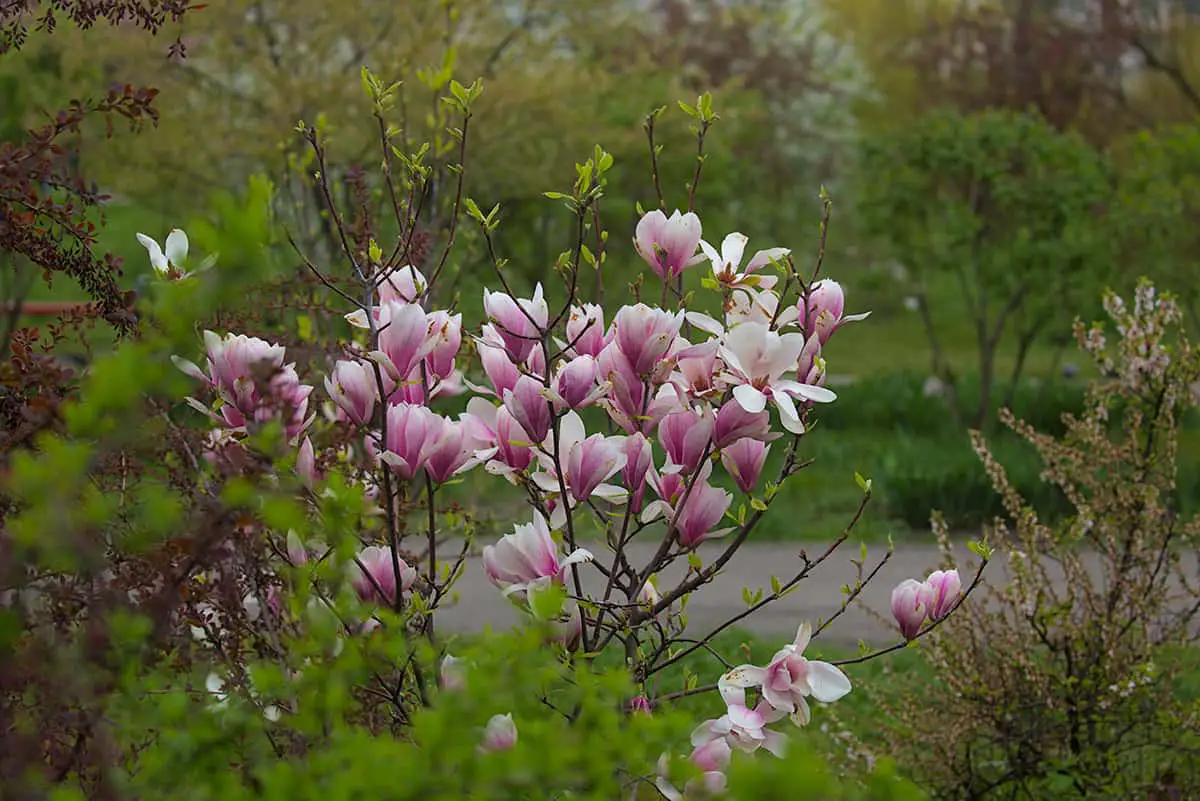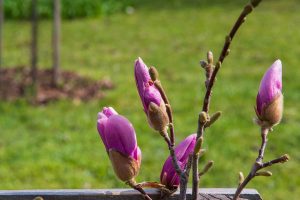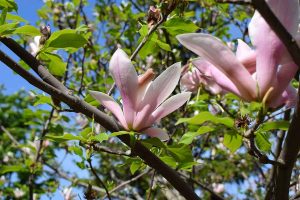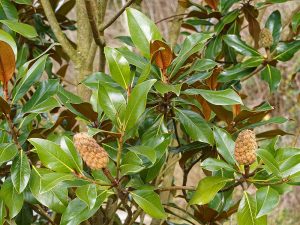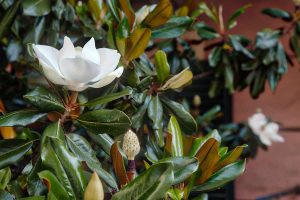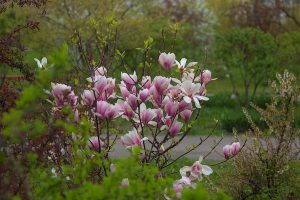Magnolia trees are exceptionally attractive specimens, producing glossy deep green foliage and an abundance of large blooms in shades of white, pink, yellow, and purple. Magnolias have a very distinctive look, which can make it a challenge to decide what to plant alongside these beautiful trees.
They are also quite particular about their growing conditions, which adds another dimension to the dilemma. Here we look at a number of plants that go well with both deciduous and evergreen magnolia trees.
Table of Contents
Choosing a Companion Plant for Magnolia Trees
Although one of the most important aspects of choosing companion plants is ensuring they look good together, you also need to ensure they have similar climate requirements and conditions of care, otherwise, some of your plants will not thrive.
Climate
The type of climate your magnolia tree should be grown in depends on the species of the plant. For example, Southern Magnolias (Magnolia grandiflora) are not hardy and prefer warm climates between USDA hardiness zones 7 to 10, while other magnolias like the Star Magnolia (Magnolia stellata) are considerably more hardy, preferring USDA hardiness zones 4 to 8.
When thinking about a companion plant for your magnolia tree it is essential to choose one which will thrive in the same climate conditions as the magnolia. This will help to ensure the long and healthy life of the companion plant.
Soil
Magnolia trees are quite fussy about their soil. They like well-draining soil which should be kept consistently moist, and they also prefer soil that is acidic. Your companion plants for the magnolia tree need to have similar preferences for soil, otherwise, they will not grow well.
Planting a shrub that thrives in dry, alkaline soils beneath a magnolia tree is obviously not going to fare well. Opt for a companion plant that also thrives in moist conditions, and is able to tolerate acidity in the soil.
Water
If you have a magnolia tree, you can expect to be watering it several times a week during dry weather. This is because most magnolia trees require soil to be kept consistently moist.
There are some varieties of magnolia which become mildly tolerant of short periods of drought once well established, but they will always perform best in moist soils. This means that any companion plants you position beneath a magnolia tree will also need to be well-suited to be watered frequently.
Light
If you are looking for a companion plant to position underneath the canopy of the magnolia tree, you will need to consider the type of light it needs. Magnolias are great for creating shade, so if you have an evergreen magnolia that has a dense canopy all year round, then the plants situated below it will need to be comfortable with shade through every season.
In the case of deciduous magnolia trees, the branches will be bare through late fall, all of winter, and into spring, so companion plants that thrive in dappled light during winter and spring will perform well beneath these trees.
Plants to go with Deciduous Magnolias
Deciduous magnolia trees shed their leaves in fall, and new leaves will emerge in late spring the following year. This means that throughout winter and into spring, the tree will create dappled shade on the ground beneath it.
However, through summer, the tree produces a dense crown of foliage, so any plants beneath the tree at this time will be in full or partial shade, depending on the size of the canopy and where the plants are in regard to the movement of the sun. When choosing a companion plant for deciduous magnolias, those which enjoy full to partial shade all year round will work well, as well as those which need light through winter and spring.
Daffodils
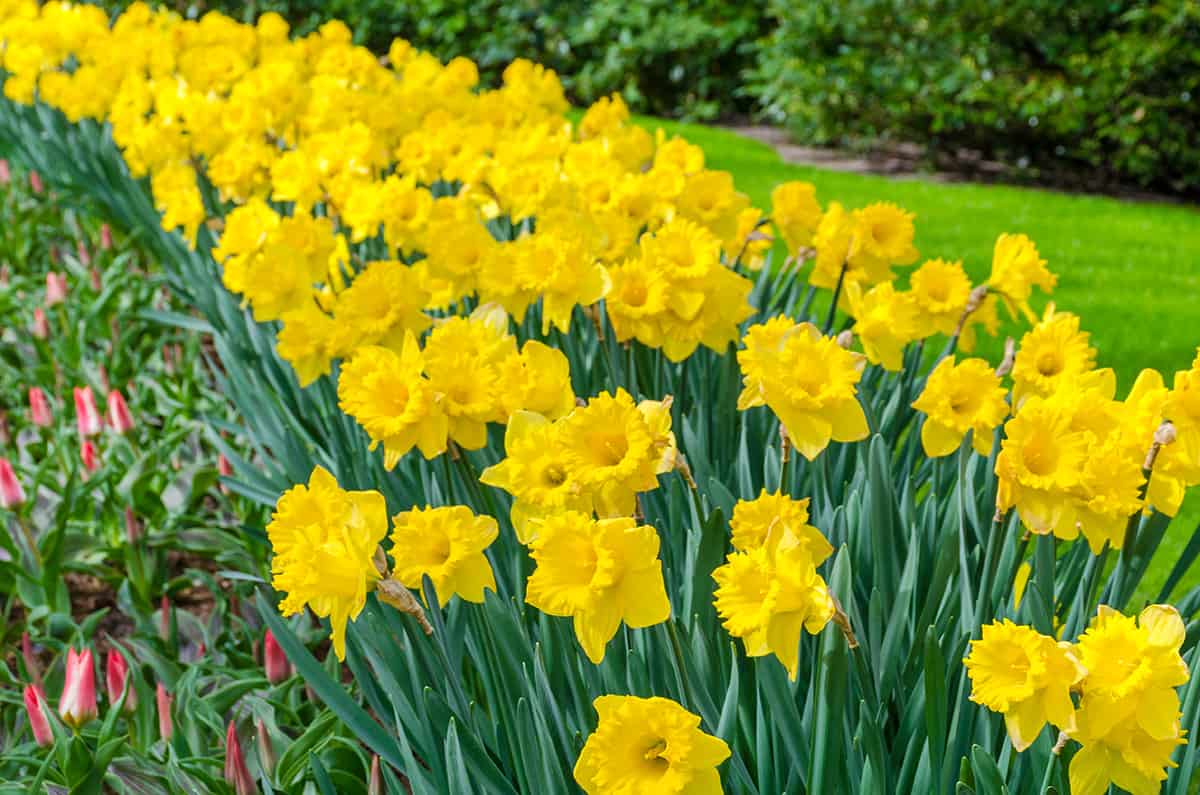
Daffodils (Narcissus sp.) are plants that grow from bulbs, and they emerge from late winter through to spring. They can grow well in a variety of sun and shade positions, which makes them ideal for growing beneath the dappled canopy of deciduous magnolia trees. Daffodils thrive in moist soil which is another reason why they are compatible with magnolia trees.
Different varieties of daffodils thrive in different climates, so you can choose a specific type of daffodil that will work well with the climate the magnolia enjoys. For example, Narcissus ‘Carlton’ produces large bright yellow flowers and thrives in cooler climates of USDA hardiness zones 3 to 8, so this will work with more hardy magnolia trees.
Narcissus ‘Ariel’ is a dwarf variety of daffodil producing dainty white flowers, which thrives in USDA hardiness zones 8 to 11, and will therefore be well suited to growing beneath a warmer climate magnolia such as the Southern Magnolia.
Daffodils will bloom throughout spring before both the flowers and the leaves die back. There will be no sign of them through much of summer, fall, and winter until they emerge again the following spring.
They are a great addition to the spring garden, but they may not be the best choice of companion plant with your magnolia tree if you are looking for a plant that adds interest beneath the tree throughout the year.
Dwarf Magnolias
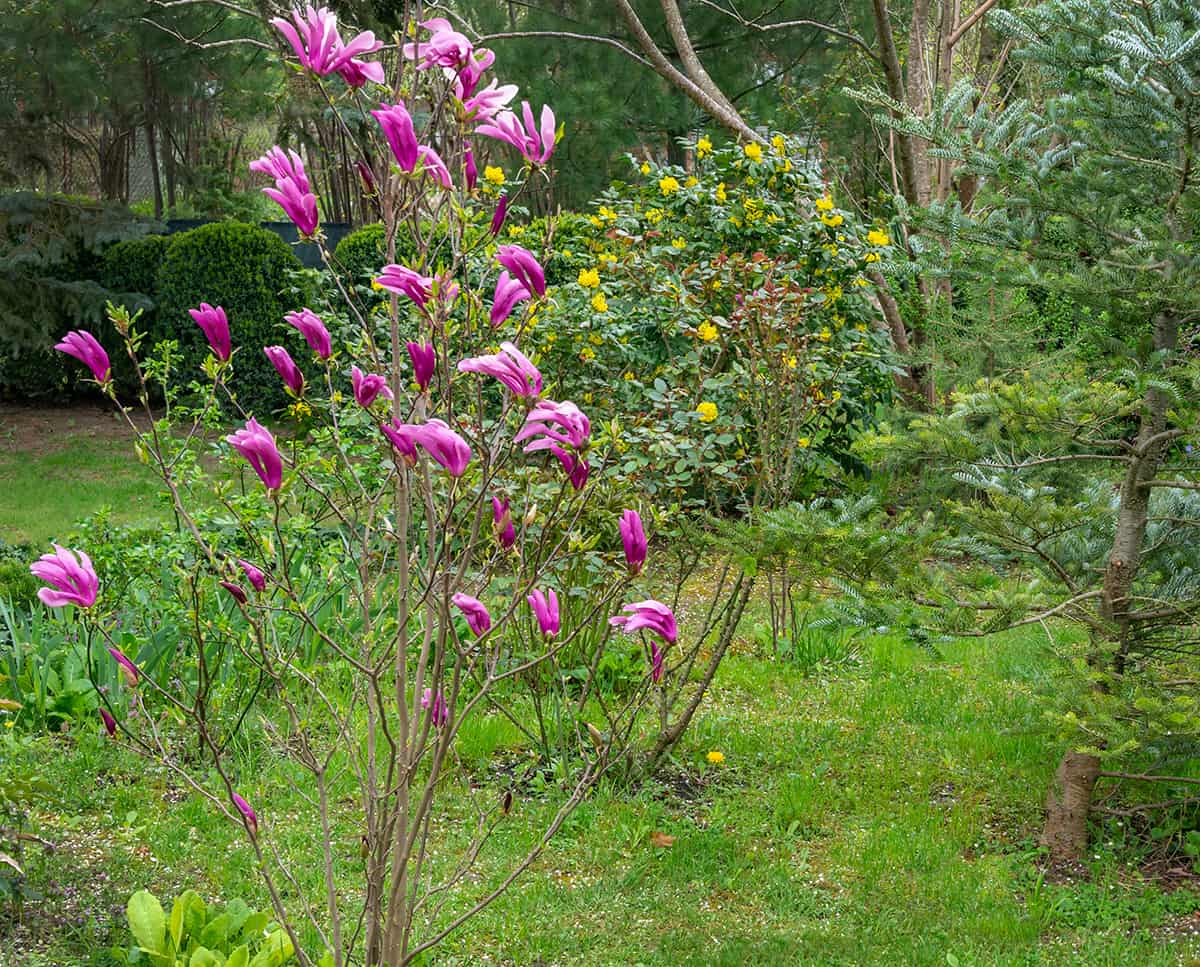
If you are looking for a plant that will work well with the growing conditions your magnolia tree enjoys, nothing will be better suited than another type of magnolia. There are many dwarf varieties of magnolia which can be grown as shrubs, and these will thrive close to a taller magnolia tree, and maintain a cohesive look.
Magnolia ‘Susan’ is a good choice for planting near a deciduous magnolia because it will only grow to a mature height of between 8 and 12 feet. It can thrive in full sun or partial shade, so it will need to be planted around the periphery of the magnolia tree’s crown, which will allow it a mix of sun and shade throughout the year.
As a fellow magnolia, both the dwarf shrub and the tree will thrive in the same soil which is moist, well-draining, and slightly acidic. Other dwarf varieties of magnolia which can be planted close to a tall magnolia tree include the Saucer Magnolia ‘Lilliputian’ (Magnolia x soulangeana) and the Magnolia ‘Genie’.
Plants to go with Evergreen Magnolias
Evergreen magnolias remain in leaf all year around, providing a good level of shade beneath their canopy. If you want to find companion plants for your magnolia which will survive underneath the shade of the tree, then they need to be plants that require very little light.
Both Hostas and Ferns are obvious choices to fill the space beneath an evergreen magnolia, as both thrive in full shade or partial shade, and enjoy consistently moist soils.
Hostas
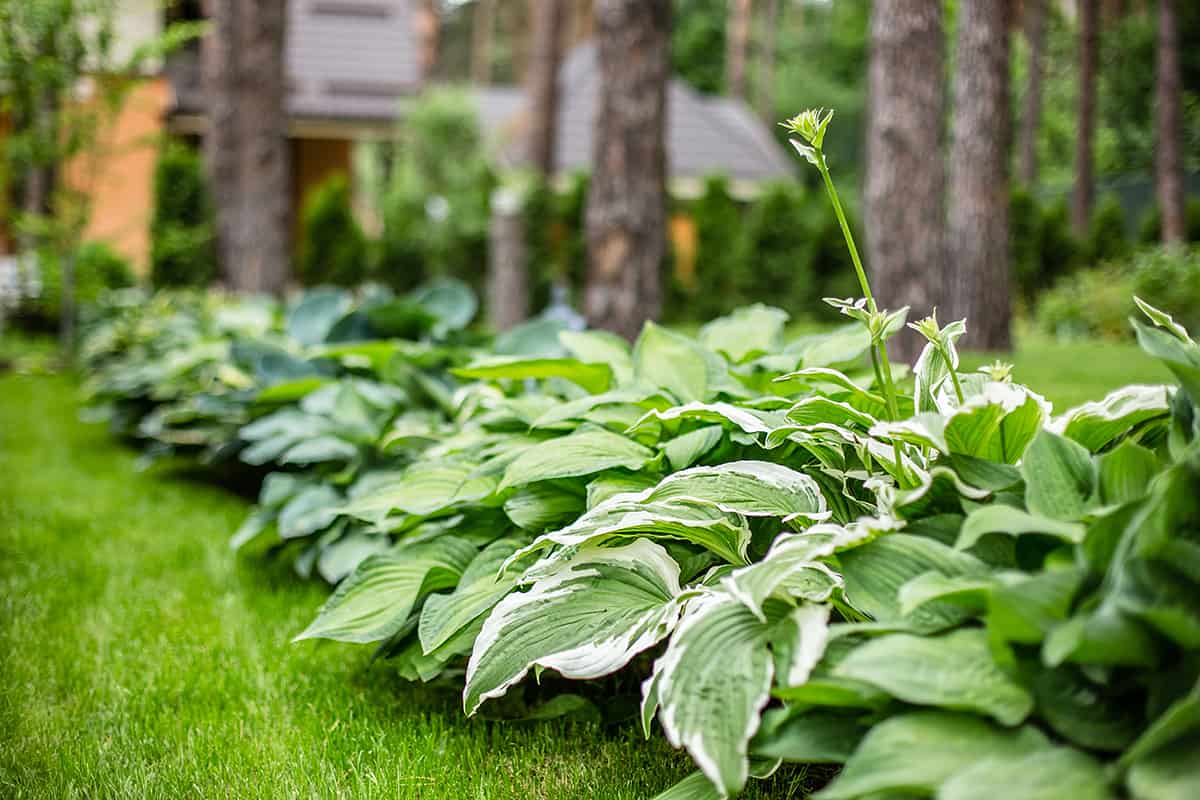
Hostas, also known as Plantain Lilies, are a genus of plants in the Asparagaceae family. They are loved for the wide variety of colors their foliage comes in, their easy-growing nature, and their ability to thrive even in deep shade. Hostas are native to Asia and grow to mature heights of between 1 and 3 feet, with a spread of between 2 and 4 feet.
Both the texture and shape of Hostas leaves are as wide-ranging as their coloring. They can come in shades of lime, deep green, blue, gray, and cream, and there are many variegated varieties that have striped or patterned leaves. As shade-loving perennials, you can cover the ground beneath evergreen magnolias in these plants, for a lush display of colorful foliage throughout every season.
They will also work well beneath the dappled shade of deciduous magnolia trees because they can tolerate partial light. Hostas also send out flowers, usually on spikes, but these are not as interesting as the foliage itself. Hostas are suitable for growing in USDA hardiness zones 3 to 9, and they thrive in moist, well-draining soil, just like magnolias.
Ferns
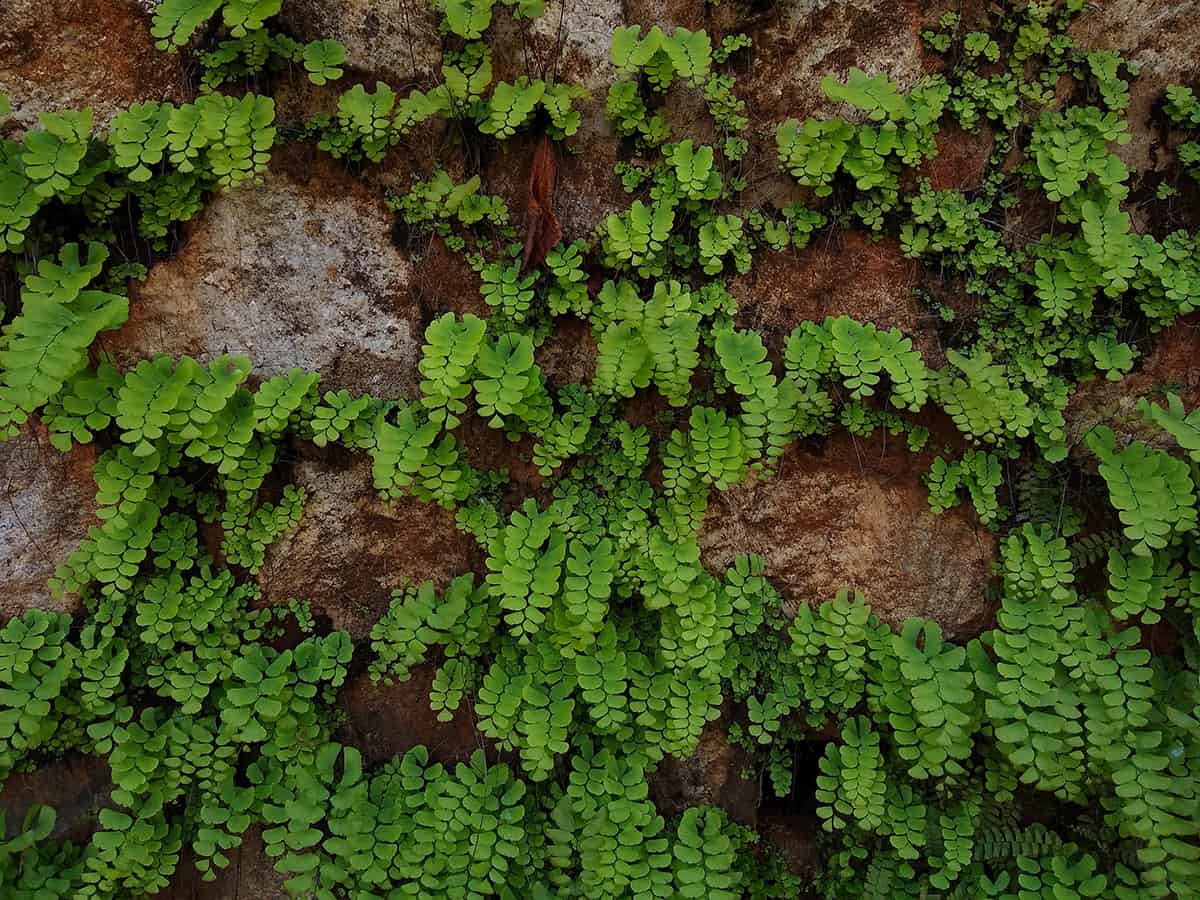
Ferns are a type of plant which do not produce flowers or seeds and instead reproduce through spores. There are a huge variety of ferns available, most of which thrive in consistently moist soils, and in shaded conditions. This makes them well-suited for life beneath the shade of a magnolia tree.
Ferns come in different sizes and colors, though most of them share similarities in terms of shape and habit. Ferns produce fronds, with small leaves lining up along thin, wire-like stems. Some popular ferns which would work well beneath a magnolia tree include the Maidenhair Fern (Adiantum aleuticum) which is hardy through USDA zones 3 to 8, the Japanese Tassel Fern (Polystichum polyblepharum) which is hardy through zones 6 to 8, and the Boston Fern (Nephrolepis exaltata) which is hardy through zones 8 to 12.
Match your fern’s climate requirements to those of your magnolia tree for a good match, and enjoy the year-round exotic-looking foliage. Some ferns can also tolerate a little light, so these would also be a good choice to grow beneath the dappled shade of a deciduous magnolia tree.
